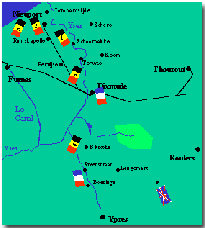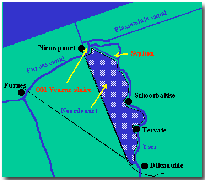Feature Articles - Brave Little Belgium - Last Stand on the Yser
 Fight For The Advanced Posts: The Royal Navy Intervenes
Fight For The Advanced Posts: The Royal Navy Intervenes
On the 14th, Belgian engineers began to prepare the defence line on the Yser. The Germans were never able to penetrate this defence, and for four more years, this was the Belgian army's calvary.
The River Yser formed a natural defensive obstacle facing the Germans in Belgium, just as the Gete and the Nete had before. But here, in the north-west corner of Belgium known as the Westhoek, the landscape was totally different. The flat coastal area, known locally as 'Bachten de Kupe' is woven through with a network of tiny drainage canals, for this is reclaimed land, or polder.
The water level is just below the surface, and is regulated by the canals, and a widespread system of sluices and pumps. The head of this system was at Nieuwpoort, where the Yser meets the sea, and where several important transportation canals join.
In the Westhoek, there were only two possible lines of defence, which were the Yser, which is canalised for much of its length, and the embankment of the Nieuwpoort - Diksmuide railway. The minor heights of the canal and railway embankments gave dominance in such flat country. The occupants could observe for many miles. The only other heights of any consequence were the high dunes around Lombardsijde, a small rise at Klerken near Diksmuide, and the Flemish hills, several miles to the south-west behind Ypres. The Belgians, in holding the embankments, were in a very strong position. The weak points in their front were the bridges over the Yser at - from north to south - St Joris, Schoorbakke and Tervate.
Diksmuide lay some twelve miles to the south of Nieuwpoort. It was of enormous importance, as the town formed a bridgehead on the eastern side of the river. Holding it gave the Belgians a starting point should the allies advance. The town was typical of West Flanders, possessing a mediaeval market square, with a beautiful 15th Century town hall and many churches.
As the Belgian divisions fell back, they took up defensive positions on the Yser and turned to the important task of fortifying the embankments.
The 2nd Division, under General Dossin, occupied the most northerly positions. They had advanced posts at Lombardsijde, on the Ketsbrug and at Mannekensvere.
The 1st Division came next, occupying important positions around Schoorbakke, with posts at Sint-Pieters-Kapelle and Zevekote.
The 4th Division, heroes of Namur, held the Tervate bridge, and placed posts at Keiem and Beerst.
The 6th Division occupied the line of the Ieperlee canal, as far south as Boesinghe. They were relieved here on the 18th October by units of the French 89th Division, and moved into reserve at Lampernisse, which is directly behind Diksmuide. The 5th Division were also in reserve.
The 3rd Division were held in reserve at Wulpen, on the Nieuwpoort-Veurne canal. GHQ and King Albert had taken up residence in Veurne, the regional capital of the intensively farmed area of the northern border with France, known for centuries as the Veurne-Ambacht.
To the south, the Territorial 87th Division of the French army, occupying the canal line as far as Ypres. Beyond them, falling back from Roeselare, the British 7th Division. And also falling back from Antwerp and Ghent, the Marins Fusiliers of Admiral Ronarc'h were taking up positions outside Diksmuide. The cavalry of De Witte worked in conjunction with the French cavalry of de Mitry, in the area of Houthulst and Staden.
On the German side, an overwhelming superiority of manpower and artillery was being amassed in front of Diksmuide and Ypres. The 22nd, 23rd, 24th and 25th Reserve Korps were being brought up by train, forming part of the 4th Army under Albrecht of Wurttemburg. The 6th Bavarian Reserve Korps took up positions south-east of Ypres. The 3rd Reserve Korps, which since the 15th October had been in occupation of Oostende, moved along the coast towards Westende.
Fight For The Advanced Posts: The Royal Navy Intervenes
The battle opened on 18th October, with a heavy bombardment all along the Belgian lines, followed by German infantry probing into the forward defences. The first serious clash occurred when a group of Belgian cyclists and lancers were shelled out of Sint Pieters Kapelle, lying a little east of Schore. After a fierce, two hour combat, the German infantry moved into the ruins of the hamlet.
At 9am on the same morning, the Belgian 2nd Division made first contact with the attacking forces of the 3rd Reserve Korps just to the east of Westende. The attack here threatened to break through, but was brought to a shattering standstill by heavy shelling from British warships lying off the coast. For during the night of the 17th/18th October, Admiral Hood had brought up three monitors, the HMS's Severn, Humber and Mersey.
(These ships were flat-bottomed and with a very shallow draught, being originally designed for the Brazilian navy operating in the estuary waters of the Amazon. They were heavily armoured, and carried two 6-inch guns and two 4.7-inch howitzers each, in addition to machine guns. Later, when attacked by torpedo, they avoided destruction, as German torpedoes generally travelled at a depth of around twelve feet. The monitors drew only four feet.)
The Germans, shocked, withdrew to Oostende. The naval shelling causes great losses among men and horses. Over the next days of the battle, the Royal Navy played a key part, keeping the coastal strip under constant fire, causing casualties and disruption to German operations. For example, on the 23rd, a Royal Navy flotilla bombarded German positions in Oostende, following an unsuccessful attempt by a German submarine on the destroyers HMS's Wildfire and Myrmidon. A British naval balloon, moored beyond German shelling at Koksijde, directed operations.
Further inland, and beyond the range of the monitors, the villages of Leke, Schore and Schoorbakke received their baptism of fire from the German heavy artillery. At Mannekensvere, the Belgian 7th Linie held on under fire all day, but were forced to withdraw in the evening. They counterattacked with the bayonet the following morning, but were brought to a halt by the weight and accuracy of the shelling.
The advance posts of the 4th Division at Keiem were lost to units of the 6th Reserve Division, but the 8th and 13th Linie attacked and recovered them at the point of the bayonet. The 6th Division were ordered to thin the ranks holding out further south to provide reinforcements at Keiem, and at other posts under similar threat. The position was increasingly precarious, and the Germans threatened to engulf the Belgian positions on the right bank of the Yser, north of Diksmuide.
The 4th Division committed its last reserves to assist the defence of the bridge at Tervate, and the 3rd Division were committed to strengthen the defences in front of Nieuwpoort. At this point, the French came to the assistance of the Belgians by relieving the 6th Division on the Ieperlee. The line held by the 40,000 effective men of the Belgian field army was reduced to 28km.
To the south of Diksmuide, there was much better news. The right wing was firmly held by the cavalry of de Witte and de Mitry, from Kortemark to Roeselare.
On the 19th, the Germans doubled their efforts to smash the Belgians and move forward along the coast into France. The village of Schore was seen as being of immense tactical importance, as the river bend between Schoorbakke and Tervate could be attacked from the flank if it could be taken.
The Belgians, incredibly enough, planned a serious counterattack. Leaving a brigade of the 3rd Division to hold the Diksmuide bridgehead, they would move the 5th Division, together with the French Marins Fusiliers, via Vladslo and Beerst, north-east towards Torhout. At the same time, the French and Belgian combined cavalry would make a daring sweep to Torhout. But it was not to be, for shortly after the infantry took up positions, Keiem fell again, and the 13th Linie had to quit Beerst (between Diksmuide and Keiem).
The Marins Fusiliers, however, continued with their part of the counterattack plan. They quickly captured Vladslo and pushed the Germans back out of Beerst, with the help of two battalions of the 4th Division.
To the north, Belgian pilots had spotted German pioneers making strongpoints at the St Joris bridgehead
The 20th saw the Germans beginning to attack the last of the forward posts. General von Beseler ordered a breakthrough between Mannekensvere and Schoorbakke. He assembled three divisions (5th and 6th Reserve, and 4th Ersatz) for the task. They, including all of their associated artillery, would face three Linie regiments, the 5th, 6th and 9th. Under this overwhelming pressure, the 9th Linie had to give up the fortified position of Bamburg farm, just east of the sluice complex at Nieuwpoort, which had held the German attempts over the last two days. Once that had gone, the German artillery turned its weight onto the canals and Lombardsijde. Gradually, the Belgian hold east of the Yser began to slip.
The heavy 210mm howitzers, recently brought up from Antwerp, now opened up on the sector between St Joris and Schoorbakke. Huge columns of water went up as shells fell in the Yser, and men died, buried by tens of feet of debris, when they fell in the trenches. The German troops, massed in Mannekensvere, moved forward. They were beaten off, countless times, by spirited Belgian small arms fire. Schoorbakke held.
The same day, a furious battle raged outside Diksmuide. The German 44th Division, under General von Dorrer, recaptured Beerst, from where, at 8am, he opened fire on the trenches surrounding the town. The bridgehead was still held by one brigade under General Meiser, consisting of the 11th and 12th Linie. The latter, under Colonel Jacques, covered the three roads into the town, from Beerst, Esen and Woumen. Meiser had in all 71 field guns. Six weakened companies of the 11th Linie, together with two machine gun sections, formed the only reserves.
The Marins Fusiliers held the trenches on the left bank of the river on both sides of the road to Kaaskerke and the coast. Admiral Ronarc'h had taken the railway station as his battle headquarters. Just on the town side of the bridge, the roof of the Minoterie gave good observation over the ruins of the town. To their left, units of the 4th Division, also occupying the far river bank and the hamlet of Oud Stuivekenskerke. (At this village, Belgian engineers had fortified the tower of a church, and its 10 feet height gave excellent observation over the river area). To the right, the 3rd Jagers.
Between 9am and 10am on the morning of the 20th, the Germans of the 43rd and 44th Divisions advanced, behind an artillery barrage. The town was quickly reduced to ruins, many houses burning to the ground. A strong wind fanned the flames along the narrow streets, and the town hall and churches were badly damaged.
The first fighting took place shortly after midday, in the area of the Handzamevaart canal between Diksmuide and Esen. By 4pm, the Belgian position in the bridgehead was becoming untenable, as the Germans captured the trenches around the town. Hand to hand fighting took place as the 11th Linie, later added to by the Marins Fusiliers, recaptured them.
A second attack now followed, but again the 11th Linie held it off. The bridgehead held. The Germans renewed the bombardment of the town. In the dusk, the petrol tanks went up, and the horizon glowed red. The holocaust continued all through the next day, and the one after that. Colonel Jaques was wounded for the second time, and command of the bridgehead devolved on Lieut-Col Sults. The Belgians beat off countless infantry attacks, and fought trench by trench to hold on to the town. Both sides suffered very heavy casualties.
On the 21st, King Albert moved GHQ to La Panne, where it was to stay until the last days of the war.
Joffre went to meet with him, and explained that the 42nd Division under General Grossetti, that had fought on the Marne, was presently on its way to Veurne. The French troops north of Ypres were to be formed into the Detachement d'Armee de Belgique, under General d'Urbal.
Early in the morning of the 22nd October, the headquarters staff of the German 6th Reserve Division were brought startling news : 'we've crossed the Yser'!. It was true : the 1st and 2nd battalions of the 26th Reserve Regiment of Infantry had, under cover of dark, quietly crossed by a temporary footbridge at Tervate. Not a shot had been fired at them. They rapidly deployed a large force into the bridgehead they had created. The Belgians organised several counterattacks during the 22nd, but all were beaten off.
Just to the north, at Schoorbakke, the conditions remained much the same as the previous day, with German attacks repulsed, despite strong artillery support.
Belgian attacks recovered Lombardsijde and Bamburg Farm.
On the 23rd, at last, the 42nd Division arrived to strengthen the garrison of Nieuwpoort. Fighting continued all along the front. The Germans repeated attacks at Nieuwpoort, Schoorbakke, and Diksmuide. They reinforced the tiny bridgehead at Tervate.
By the 24th, Belgian resistance was deteriorating due to the exhaustion of the troops and lack of ammunition. The only reinforcements that had been forthcoming were the French 42nd Division. On this day, there were 15 separate infantry attacks at Diksmuide alone, and the exceptionally heavy bombardment continued to reduce the town to rubble. But the Belgians held on. On the 26th, they were at last reinforced by two Senegalese divisions.
The Flooding Of The Polders
For some time, the Belgian engineers had been considering an alternative, somewhat drastic form of defence, suitable only in this low lying country. The whole area was intersected with canals and ditches : the possibility existed of artificially raising the water level, and flooding the fields to a depth to render the Germans incapable of offensive operations. (The Belgians had also prepared some of the river bank areas of Antwerp for this eventuality). The engineering operations required for such a task entailed damming the 22 culverts that ran below the Nieuwpoort - Diksmuide railway embankment, and then opening the main sluices at the canal complex at Nieuwpoort.
This was a very complex plan, as it depended on the right tides, force and direction of wind, and the feasibility of opening the old sluice of Veurne. The latter consisted of two gates which needed to be held open constantly, with one set of ebb-tide doors free to move with the rise and fall of the water. At the other sluices, the doors and gates had to be operated manually (they are now electric and automatic).
There was a full moon on 29th October : this was known to create the right tidal conditions for the operation, so set the timetable. The operations began as early as the 21st October, when the overflow of the Old Yser was opened. The Noordvaart - Old Yser syphon was at the same time closed to avoid flooding the area occupied by the 2nd Division.
German pressure was such that Foch briefly considered similar flooding operations east of Dunkirk, on the 25th. The next day, the first attempt to open the old sluice of Veurne failed. Two days later on the 28th, a second attempt succeeded, and the waters began slowly to rise. At 7.30pm on the 29th, the Noordvaart was also temporarily opened to take advantage of the high tides; this operation was repeated on the 30th.
While these aquatic operations were in hand, the German pressure continued. The Belgians were forced to withdraw from St George's, over the Noordvaart, and by the 26th they had taken up positions at Ramskapelle, on the embankment south of Nieuwpoort.
This withdrawal was undertaken, of course, in the knowledge that the waters were going to rise. The last troops across were moving through inches deep water. By this time, Belgian ammunition stocks were desperate: the field guns were down to their last 100 rounds. King Albert was advised by Foch to withdraw from the Yser area, to take up a position behind the Veurne - Ypres canal. This he refused to do. It is easy to speculate his rationale: it meant effectively giving up the last portion of Belgian territory; it also assumed the flooding operations were going to fail.
Despite the rising waters, the Germans advanced on Ramskapelle, and penetrated into the ruins of the village, only to be repulsed at the point of the bayonet by a mixed Franco-Belgian counterattack.
The few Belgian troops still holding the river banks quietly withdrew over the 24th to 27th October, as the waters rose. On the 31st, the German once again attacked at Ramskapelle, but were thwarted by strong Belgian resistance and the sheer impossibility of operating in these conditions. Following this failure, the Germans closed down offensive operations on the Yser, and turned their attentions to Ypres. The Belgians still held Belgium.
Article contributed by Chris Baker, website.
3 British Officers were executed by courts martial during the war, as opposed to 316 Private soldiers and 24 Non-Commissioned Officers. The vast majority were for desertions.
- Did you know?


